The system of government in
Saudi Arabia is a royal dynasty, and the King, the Cabinet and the Shura
Council constitute the executive and legislative powers in the country.
There are 20 ministries as well as a number of governmental departments.
The Prime Minister is the Custodian of the Two Holy Mosques King Fahd bin
Abdulaziz Al Saud. The Deputy Premier is HRH Prince Abdullah bin Abdulaziz,
Crown Prince and Head of the National Guard, while the Second Deputy
Premier is HRH Prince Sultan bin Abdulaziz, Minister of Defence and
Aviation and Inspector General.
During the period of his rule, the Custodian of the Two Holy Mosques King
Fahd bin Abdulaziz has issued four decrees regarding the organization of
the system of government. These deal, respectively, with the constitution,
the shura system, regional government and the cabinet. Under one of these
provisions administrative and executive government appointments are valid
for a limited period of time, generally four years, after which they are
either reinstated or new appointments are made, thus making it possible
for young and efficient nationals to actively participate in the process
of development.
The foreign policy of the Kingdom is based on deep-rooted pillars derived
from Islamic teachings and Arab and Islamic solidarity; defending Arab and
Islamic just causes; service of Islam and Moslems worldwide; preservation
of world peace and stability; and non interference in other countries'
internal affairs.
The Kingdom of Saudi Arabia is a forerunner in providing aid and
assistance to developing countries. The Kingdom's foreign aid and
assistance has reached 5.45 per cent of its GDP, against that of the large
industrial countries whose assistance rate was less than .2 per cent in
1992. Meanwhile, the UN has proposed that such assistance should be at a
rate of 7 per cent of the donor country's GDP. The Kingdom's total
assistance up to the end of 1995 reached more than $71 billion in the form
of non-refundable aid and soft loans, provided to 70 countries worldwide
(38 African, 22 Asian and 10 developing countries) the Kingdom also
contributed towards building numerous mosques, Islamic centres, schools,
institutes, universities, hospitals and medical centres in various parts
of the world. Over the 20 year period, from 1975 to the end of 1996 the
Saudi Development Fund offered loans worth more than $5.71 billion to
finance 312 projects in 63 countries. The Kingdom also provided
humanitarian aid to victims of civil wars and natural crises in Islamic
and Arab countries.
Saudi Arabia has an area in excess of 2.25 million sq. kms. As such, it occupies almost 85 per cent of the Arabian Peninsula. There are four geographic areas, i.e. a central plateau known as the Nejd, an eastern province, Al-Hasa; its northwestern region, the Hejaz and a southwestern area, the Asir. Each of the these has its own distinctive features and character; one of the most dramatic being the mountain range that runs along the entire western side of the Kingdom, more or less parallel with the Red Sea coastline. Known for its deserts, the renowned Rub al-Khali or Empty Quarter, one of the largest in the world, occupies approximately half of country's land area. The Kingdom also has a number of islands, both in the Gulf and in the Red Sea with its largest archipelago being the Farasan islands, off its southwestern shores. Its marine environment is rich in sealife and coral reefs are well developed.
Heritage and CultureThe guiding influence in
Saudi Arabian life and culture is that of Islam. The Saudi Arabian
government plays an important role in caring for the Two Holy Mosques and
in hosting the millions of pilgrims who visit the country.
Since the era of King Abdulaziz, the Kingdom of Saudi Arabia has spared no
effort in caring for the Two Holy Mosques and the many pilgrims who visit
them. Expansion and renovation works have continued unabated. The Holy
Mosque in Makkah has been expanded in order to increase its capacity from
410,000 to 773,000 worshippers, with up to one million worshippers at peak
seasons during the Pilgrimage and the holy month of Ramadan. The Holy
Mosque in Medina was also expanded from 16,000 sq.m to 165,500 sq.m in
order to raise its capacity from 28,000 to 700,000 worshippers with up to
one million on peak occasions. The total cost of the expansion reached
more than $22.5 billion. In addition to this work, the Kingdom also
sponsors production of large numbers of the Holy Quran. Established in
1985, the King Fahd Complex for Printing the Holy Quran produces 10
million copies per year in addition to other publications including
foreign language editions of the Holy Quran.
In order to maximize the benefit from the large number of livestock that
are slain during the pilgrimage season, the Islamic Development Bank has
been involved, since 1983, in distributing more than 500,00 livestock each
year to refugee camps and needy people in some 27 Arab and Islamic
countries.
Information and Media
The information policy of the Kingdom of Saudi Arabia is based on Islamic teachings. The Higher Council of Information whose membership consists of an elite of politicians, intellectuals and writers supervises this objective and well-balanced policy. The Saudi broadcasting service, which covers all parts of the country, comprises a general programme, a second programme, Holy Quran service, and Islamic Call service as well as other programmes in different languages. There are two TV channels in the Kingdom and the Saudi News Agency broadcasts its services around the clock in
Arabic, English and French languages. There are also 12 daily newspapers in the Kingdom, three of which are in English, in addition to four weekly magazines and a number of specialized magazines and periodicals.Environment and Wildlife
The Kingdom of Saudi Arabia
pays special attention to the protection and preservation of its natural
environments and wildlife. In this regard, Article 32 of the Constitution
stipulates that "the Government should endeavour to preserve, and
develop the environment and protect it from pollution". In 1986, the
Custodian of the Two Holy Mosques King Fahd bin Abdulaziz issued a royal
decree establishing the National Commission for Wildlife Conservation and
Development (NCWCD), chaired by HRH Prince Sultan bin Abdulaziz, Second
Deputy Premier and Minister of Defense, Aviation and Inspector General and
Chairman of the Higher Committee of the Environment.
The NCWCD's strategy concentrates on the protection of wildlife,
particularly the endangered species; issuing regulations and rules
supporting environment protection and development; and promoting public
awareness about the importance of wildlife.
The NCWCD is headquartered in Riyadh but has centers of activity
throughout the country. The conservation body has been responsible for
surveying, recommending and administering a large number of protected
areas. The first national park was Harrat al-Harrah, which comprises a
vast area of stony desert in the north of the country where ten different
species of lark breed and where large numbers of sand grouse live. Other
avian residents include golden eagle, long numbers of sand grouse live.
Other avian residents include golden eagle, long legged buzzard, merlin,
cream-coloured courser, little owl, and Saker's falcon. This was the last
area in Arabia where ostriches lived, being seen here up to 1930. Other
important designated nature reserves and protected areas are At-Tubayq,
Jabal Aja and northern Hail, and the Gulf Coral Islands, with Special
Nature Reserves already declared at Al Ha'ir, Hawtat Bani Tamim, Mahazat
as-Sayd, Umm al-Qamari and the Farasan Islands. Meanwhile, the
traditionally protected area, Hima al-Fiqrah mountainous region where
leopard, wolf and ibex still occur, also receives administrative
protection.
Wildlife highlights include many excellent places to observe bird life
with a recent publication issued by Birdlife International (Important Bird
Areas in the Middle East) listing 39 sites in Saudi Arabia and noting that
over 100 sites have been earmarked for protection by the NCWCD. Marine
life can be studied while diving both in the Gulf and Red Sea, with the
former offering more shallow sandy and sea-grass sea-beds whilst the Red
Sea remains famous for its coral reefs and deeper clear waters.
Efforts to breed and re-introduce into the wild several species of
endangered wildlife, including Arabian oryx and sand gazelle have been
successfully undertaken in Saudi Arabia.
Economic Development
In 1995 the Kingdom
commenced working under its sixth comprehensive economic and social
five-year plan. During the last five development plans, the Kingdom
succeeded in establishing its infrastructure
of roads, seaports, airports and other facilities and services. The total
cost of these five plans reached more than $1,123 billion.
Within its efforts to diversify its economic production base and reduce
dependence on oil as the sole source of national income, and according to
the Ministry of Planning statistics, the non-oil GDP rose four-fold from
1970 to 1990 with an annual growth rate of 6 percent, while the rate of
non-oil revenues' contribution to the total government revenues increased
from 16 percent to 22 percent. The annual growth rate of the added value
of the manufacturing industries reached 7.4 percent, and the value of
commodity exports jumped from $7.46 million to $4.1 billion during the
same period due to the remarkable growth in petrochemical exports.
Meanwhile, the private sector's annual investment volume rose from $266.66
million to $12.26 million. The private sector's contribution in the GDP
rose from 21 percent to 45 percent and about 72 percent in the non-oil
GDP. According to World Trade Organisation figures, the Kingdom of Saudi
Arabia ranked 26 in the list of the major commodity exporting countries in
1995. The Ministry of Finance and National Economy statistics show that
the GDP has registered positive growth for the fourth year consecutively.
In 1997 it reached 7.1 percent according to current prices compared to 8.6
percent in 1996. By the end of 1997 the GDP was estimated at $145.86
billion compared with $136.26 billion in the previous year. The private
sector contribution in the GDP reached 34 percent according to current
prices (46.7 percent according to fixed prices) at the growth rate of 4.1
percent compared with 3.5 percent in 1996. The growth rate of the non-oil
manufacturing industries and construction and building sector was 8.6 and
4.2 percent consecutively. There were also promising signs of improvements
in the balance of payments for the second consecutive year.
In line with government policy on the subject, the Council of Ministers
has approved the general framework for a privatisation strategy. In this
respect, the Cabinet approved plans to convert the Saudi
Telecommunications Corporation together with its carious facilities into a
stock company. In addition, the private sector has taken over
administration and operation responsibilities for the General Ports
Authority.
The industrial sector has made great strides in contributing towards the
Kingdom's economic development, particularly within the petrochemical
sector whose products are now exported to 90 countries worldwide. The
Kingdom is justifiably proud of achieving self-sufficiency in a number of
industrial commodities. There are now 2538 factories in the Kingdom at a
cost of $43.9 billion accommodating about 240,000 workers compared to 199
factories in 1970 at a cost of only $743.2 million providing work for work
for 14,000 workers. In addition to this 12 fold growth, the contribution
of the industrial sector in the GDP has increased from 6.5 percent in 1980
to 12.3 percent in 1996. The production of the Saudi Arabian Basic
Industries Corporation (SABIC) 17 complexex now exceeds 24 million tonnes
of petrochemicals, fertilisers, iron and steel.
Considerable progress has been made towards self-sufficiency in foods,
especially wheat, dates, dairy and poultry products, with a surplus for
export in these items. Since the early 1980s the agricultural sector
achieved record figures in most areas of activity. The area under
cultivation increased from 600,000 hectares in 1980 to 1.7 million
hectares in 1995. The agricultural sector grew by 8.6 percent and its
contribution in the GDP rose to more than $8 billion. The Kingdom's
production of wheat reached 4.2 million tonnes in 1992. However, under the
water rationalisation of vegetables roses to 2.7 million tonnes and fruits
to more than one million tonnes of which 598,000 tonnes are dates. As
regards dairy and poultry products, the production of milk rose to 749,000
tonnes, eggs 125,000 tonnes, poultry meat 397,000 tonnes, livestock meat
150,000 and fish 54,000 tonnes.
In the field of water resources and supply, 186 dams were built throughout
the Kingdom for storage of rain water with a total capacity of 775 million
cubic meters. The Kingdom also paid special attention to desalination of
sea water to meet the daily demand for freshwater. By the end of 1997
about 25 seawater desalination plants were established along the Red Sea
and the Arabian
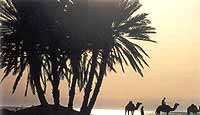
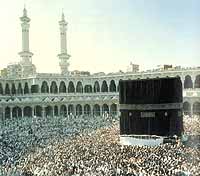
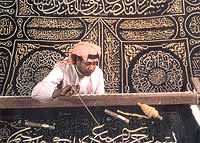
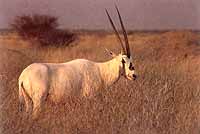
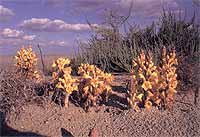
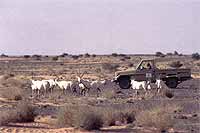
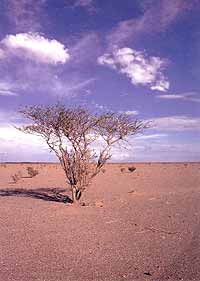
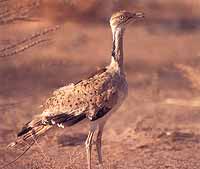

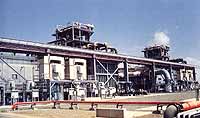
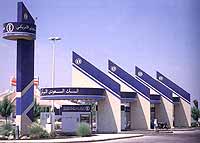
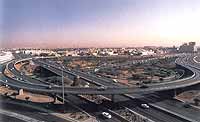


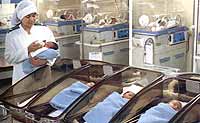
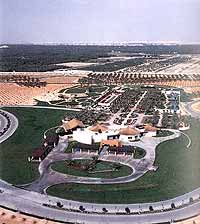
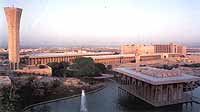
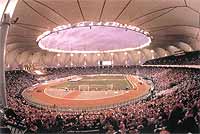
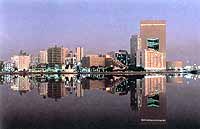
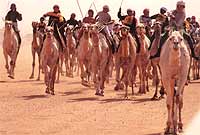
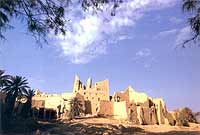
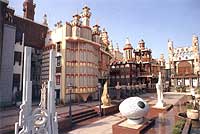
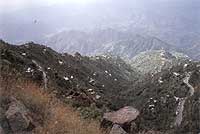
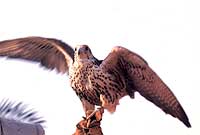
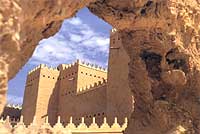
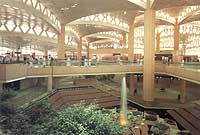
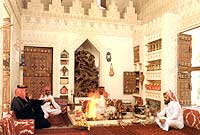
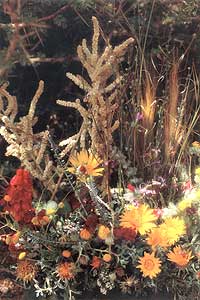
The Kingdom of Saudi Arabia has a highly sophisticated telecommunications network serving all areas and maintains direct telephone links with 200 countries. There are presently around 2.3 million telephone lines, including 300,000 mobile telephone subscribers and 16,000 car phones.
Meanwhile, pager and telex networks accommodate more than 30,000 lines. Expansion work currently underway will raise the capacity to more than 3.5 million lines out of which 500,000 will be mobile phones.
All parts of the country are now connected by state-of-the-art networks of roads and highways with a total length of 44,000 kms as well as 96,000 kms of paved roads in agricultural areas. In addition, the railway route inaugurated by the late King Abdulaziz in October 1951 has been reinstated, with a new route built in 1985 to connect Riyadh and Dammam, handling 500,000 passengers and about 2 million tonnes of goods. Given the great distances involved it is not surprising that air-travel is one of the primary means for moving both people and goods. The number of airports in the Kingdom rose from 16 in 1970 to 24 in 1995, three of which handle international flights. In the field of sea transport, the number of Saudi shipping companies reached 114 and the number of berths in the Kingdom's commercial sea ports along the Red Sea and Arab Gulf coasts rose from 27 in 1975 to 182 in 1995.
Credit funds, established by the Government to provide financial loans to citizens, have played an important role in boosting development in all fields. The total value of loans offered by the Housing Development Fund since its establishment in 1974, up to 1995, reached $29.95 billion, contributing towards the construction of 513,120 housing units. Likewise, the overall loans provided by the Industrial Development Fund over the period 1974 to 1996 reached $8.18 billion contributing in financing 2,515 industrial projects. On the other hand, the Saudi Arabian Agricultural Bank provided loans worth worth $7.71 billion to farmers and agricultural firms during the period from 1962 to 1996. This has contributed largely towards new projects for the production of vegetables, fruits, dairy products and meat. The General Investment Loan Fund has provided loans worth $14.1 billion to national corporations and companies, while the Saudi Loans Bank has granted $1.44 billion of loans to low income citizens in order to help them meet marriage, medical treatment and house renovation requirements, with some 367,581 people benefiting from these loans. In addition, several specialised loans worth $1.09 billion have also been provided to hotels, private hospitals, bakeries, contractors and newspapers.
Tourism is a growing area of economic activity in the country which is blessed with a wide range of climatic conditions, beautiful beaches, public parks and gardens, recreational facilities, a state-of-the-art road network and regular air flights. The most important tourist areas are Shfa, Hada and Radf in the Taif area, as well as Asir and Al Bahah regions, which are at elevations of up to 2500 meters above sea-level and surrounded by Tihama and Al Sarat mountains. The Al Bahah area also includes Raghdan and Wadi Almalad forests, Wadi Beeda and Marzoog falls. The city of Jeddah at the Red Sea coast is another tourist attraction with its beautiful beaches, coral reefs and marine life.
Social Development
Social amenities have been
a prime concern with considerable efforts expended to ensure that citizens
benefit across a broad range of categories, from health care to education
and housing. The Ministry of Public Works and Housing carries out a number
of projects throughout the Kingdom to provide suitable residences to low
and medium income citizens. The programme includes two types of housing;
i.e. urgent housing met by building apartments and multi-story buildings
scheduled for completion within two years; and general housing, such as
villas and houses for different categories of citizens.
The number of urgent housing units in Riyadh, Jeddah and Dammam reached
4752 apartments at a total cost of $1,389,780 million, while the units of
the general housing programme in Riyadh, Jeddah, Khobar, Buraidah, Medina,
Makkah, Qateef and Al Hasa reached 10,516 villas and 9934 houses at a
total cost of $3,558,750 million.
The Ministry of Defence and Aviation, the National Guard and the Ministry
of Interior have established for their employees substantial building
complexes equipped with all necessary amenities. In line with the
Kingdom's policy of providing suitable and comfortable residence for its
citizens, the Housing Development Fund was established in 1974 to help
citizens build their own homes through non-profitable long-term loans. The
number of units built with financial support of the Fund reached 513,120
by the end of 1995. The investment loans of $1.38 billion have largely
contributed in building 29,390 units, 5190 commercial buildings and 2857
offices.
Education is provided freely to both citizens and residents. Moreover,
special financial allowances are offered to university students in
addition to health care, accommodation and transportation. During
1970-1997 the number of students increased eight fold in the general and
high education levels, and the total number of schools rose from 3283 to
22,300. In the academic year 1997-1998 the total number of students
increased to 4.5 million out of which 300,000 are university and teacher
training college students, 29,000 in technical colleges, and 10,000
receiving training in vocational training centres.
State-of-the-art health services, comprising up to date hospitals and
medical centres are spread throughout the country, providing free services
to both citizens and residents. Health facilities are of three basic
types; i.e. medical centres, public hospitals, and specialised hospitals
for critical conditions. By the end of 1996 the total number of hospitals
in the country reached 290 out of which 179 are governmental, and the rest
are either private or owned by some government departments. The number of
medical centres rose to 2,329, about 1731 of which are governmental. The
total number of beds reached 42,652 in both public and private hospitals
with 2.32 beds for each 1000 patients), as well as 61,214 nursing staff,
and 31,977 assistant medical staff in all health and medical
sectors.
The Ministry of Labour and Social Affairs has 77 care centres for orphans
delinquents, handicapped, elderly and paralysed people. Social security
entitlements increased from $400 million in 1973 to $700 million in 1993
distributed through 76 offices, Meanwhile, the General establishment of
Social Insurance, established in 1973, is providing its services to more
than 19,800 establishments. Up to 1996 the establishments had provided
$4.6 billion as assistance to workers, more than $4.27 billion of which
was for retirement, and about $64.53 million for work-related accident
compensation.
Since the 1960's the government has undertaken major programmes aimed at
developing local communities and increasing the role of public support in
social and economic development. To this end it established 16 centers in
rural areas and seven in urban areas, in addition 65 local committees in
remote areas. The Ministry of Labour and Social Affairs, in cooperation
with the Ministries of Education, Health, Agriculture, and Municipality
and Rural Affairs is working through these centres to promote and improve
life in their communities and encourage people to engage in privately
organised development projects. Some 160 charitable societies were
established in the connection, together with 164 multipurpose cooperative
societies.
Youth sports have made notable strides locally, regionally and worldwide,
clearly reflecting the special attention paid to the youth sector. The
General Presidency for Youth Welfare has been active in promoting sport,
cultural and artistic activities. As a result, Saudi youths won major
awards at many championships and made their mark at regional and
international events. In addition to providing assistance to sport
associations and clubs, the Presidency established 73 youth facilities for
different youth activities. There are now 6 stadiums, 17 sport and
cultural cities and centres, 19 youth hostels, 2 permanent youth camps, 12
cultural clubs, 153 sport clubs and 21 sport associations.
Saudi Arabia at a Glance
Location: The Kingdom of Saudi Arabia lies at the far south western part of the Asian continent and occupies almost 85 percent of the Arabian Peninsula's area. It borders the Red Sea to the west; Jordan, Iraq and Kuwait to the north, the Arabian Gulf, Bahrain, Qatar and UAE to the east; and Yemen and the Sultanate of Oman to the south.
Area: The total area of the Kingdom is over 2.25 million sq.kms
Administrative areas:
The Kingdom of Saudi Arabia consists of 13 administrative areas, and each
area consists of a number of provinces as follows:
- Category A: 43 provinces.
- Category B: 61 provinces.
Constitution and Government: Based on the Holy Quran and the Prophet's administrative Sunnah (PBUH). The system of government is a royal dynasty, with the King, the Cabinet and the Shura Council constituting the executive and legislative powers in the country.
Climate: Inland - hot and dry in summer and cooler and drier in winter. It is more temperate at the Coastal and south western areas, particularly Alsarwat and Aseer mountainous areas.
Population: Recent figures as follows: 16,929,294. 12,304,835 are Saudis and the rest are expatriates.
National Day: 23 September (i.e. the date upon which the late King Abdul Aziz Al Saud united the country as the Kingdom of Saudi Arabia in 1932).
Religion: Islam
Capital: Riyadh
Important towns: Riyadh, the capital of the Kingdom, is one of the fastest growing capitals in the world. It has an area of 1600 sq kms with a population of three million people. Other important cities and towns are the two Holy cities of Makkah and Medina, Jeddah (the main sea port at the Red Sea), Dammam, Abha, Hayel, Al Baha, Khobar, Taif, Tabook, Ihsaa, Najran, Gizan and Jouf.
Language: Arabic
Time: 3 hours ahead of GMT
Work Hours: Government departments (from 0730 to 1430) Banks (from 0800 to 1200, and from 1630 to 1900) Shopping centers and markets are open until 2200.
Official Holidays: Thursday and Friday. Other Islamic holidays are: Lesser Bairam (Fitr): from 25th Ramadan to 5th Shawal; Greater Bairam (Adha): from 5th to 15th Thil Hijjah
Currency: Saudi Riyal. US$=3.75 Riyal.
EGYPT - SYRIA - JORDAN